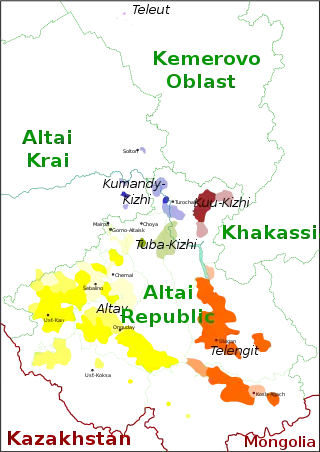| Northern Altai | |
|---|---|
| тÿндÿк алтай тили, tündük altay tili | |
| Native to | Russia |
| Region | Altai Republic Altai Krai |
Native speakers | 57,000 speakers (2010)[1] |
Turkic
| |
| Dialects |
|
| Cyrillic | |
| Language codes | |
| ISO 639-3 | atv |
| Glottolog | nort2686 |
| ELP | Northern Altai |
 Map showing the locations of the Northern and Southern Altai varieties in Russia | |
Northern Altai or Northern Altay is the several tribal Turkic dialects spoken in the Altai Republic of Russia.[2] Though traditionally considered one language, Southern Altai and the Northern varieties are not fully mutually intelligible. Written Altai is based on Southern Altai, and is rejected by Northern Altai children.[1]
Northern Altai is written in Cyrillic. In 2006, in the Altay kray, an alphabet was created for the Kumandin variety.[3]
Phonology
Northern Altai has 8 vowels, which may be long or short, and 20 consonants, plus marginal consonants that occur only in loan words.[4]
Vowels
| Front | Back | |
|---|---|---|
| High | i y | ɯ u |
| Low | e ø | a o |
Consonants
| Labial | Alveolar | Post-alveloar | Velar | Uvular | |
|---|---|---|---|---|---|
| Plosive | p b | t d | c dʒ | k ɡ | q |
| Affricate | ts[lower-alpha 1] | ||||
| Fricative | f v | s z | ʃ ʒ | x[lower-alpha 1] ɣ | |
| Nasal | m | n | ŋ | ||
| Trill | r | ||||
| Approximant | l | j | |||
Demographics
According to data from the 2002 Russian Census, 65,534 people in Russia stated that they have command of the Altay language.[5] Only around 10% of them speak Northern Altay varieties, while the remaining speak Southern Altay varieties. Furthermore, according to some data, only 2% of Altays fluently speak the Altay language.[6]
Varieties
Northern Altay consists of the following varieties:
- Kumandy dialect (also Qubandy/Quwandy). 1,862 Kumandins claim to know their national language,[7] but 1,044 people were registered as knowing Kumandy.[8] Kumandy has the following three sub-varieties:[9]
- Turačak
- Solton
- Starobardinian
- Chelkan dialect (also Kuu/Quu, Chalkandu/Shalkanduu, Lebedin). 466 Chelkans claim to speak their national language, and 539 people in all claim to know Chelkan.
The Tubalar language (also known as Tuba language), is also often ascribed to belong to the Northern Altai group, but its relation to other languages is dubious and it may belong to Kipchak languages.[10] 408 Tubalars claim to know their national language, and 436 people in all reported knowing Tuba.
Closely related to the northern varieties of Altay are the Kondoma dialect of the Shor language and the Lower Chulym dialect of the Chulym language.[10]
Linguistic features
The following features refer to the outcome of commonly used Turkic isoglosses in Northern Altay.[11][12][13]
- */ag/ — Proto-Turkic */ag/ is found in three variations throughout Northern Altay: /u/, /aw/, /aʁ/
- */eb/ — Proto-Turkic */eb/ is found as either /yj/ or /yg/, depending on the variety
- */VdV/ — With a few lexical exceptions (likely borrowings), proto-Turkic intervocalic */d/ results in /j/.
References
- 1 2 Northern Altai at Ethnologue (25th ed., 2022)

- ↑ "Northern Altai". ELP Endangered Languages Project. Retrieved 2021-07-15.
- ↑ В Алтайском крае издана азбука кумандинского языка. 2006
- ↑ Baskakov, N.A. (1997). "Altaysky yazyk" Алтайский язык [Altai language]. In Institut Jazykoznanija (ed.). Tyurkskie yazyki Языки мира: тюркские языки [Languages of the world: Turkic languages]. Jazyki mira / Rossijskaja Akademija Nauk, Institut Jazykoznanija. [Glav. red. koll.: V. N. Jarceva (otv. red.) ...] Biškek: Kyrgyzstan. ISBN 978-5-655-01214-1. OCLC 42579926.
- ↑ Всероссийская перепись населения 2002 года. Том 13. «Коренные малочисленные народы Российской Федерации»
- ↑ Энциклопедия «Кругосвет»
- ↑ Russian census figures
- ↑ Russian census figures
- ↑ BASKAKOV, N. A. (1958). "LA CLASSIFICATION DES DIALECTES DE LA LANGUE TURQUE D'ALTAÏ". Acta Orientalia Academiae Scientiarum Hungaricae. 8 (1): 9–15. ISSN 0001-6446. JSTOR 23682215.
- 1 2 Tubalarskie ėti︠u︡dy. Tatevosov, S. G. (Sergeĭ Georgievich), Татевосов, С. Г. (Сергей Георгиевич), Moskovskiĭ gosudarstvennyĭ universitet im. M.V. Lomonosova. Filologicheskiĭ fakulʹtet., Московский государственный университет им. М.В. Ломоносова. Филологический факультет. Moskva: IMLI RAN. 2009. ISBN 9785920803504. OCLC 613983309.
{{cite book}}: CS1 maint: others (link) - ↑ Baskakov, Nikolay Aleksandrovich (1966). Диалект Черневых Татар (Туба-Кижи): грамматический очерк и словарь. Moscow: Наука.
- ↑ Baskakov, Nikolay Aleksandrovich (1972). Диалект Кумандинцев (Куманды-Кижи): грамматический очерк, тексты, переводы и словарь. Москва: Наука.
- ↑ Baskakov, Nikolay Aleksandrovich (1985). Диалект Лебединских Татар-Чалканцев (Куу-Кижи). Москва: Наука.
External links
- "Кумандинский язык". Малые языки России (in Russian). Retrieved 2022-05-31. Page about the Kumandy variety with maps and grammatical information.
- "Челканский язык". Малые языки России (in Russian). Retrieved 2022-05-31. Page about the Chelkan variety with maps and grammatical information.
- "Тубаларский". Малые языки России (in Russian). Retrieved 2022-05-31. Page about the Tubalar variety with maps and grammatical information.